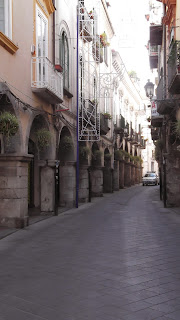Italy’s worst but little known train tragedy
 |
| One of several graphic images from the Balvano Disaster shows the bodies of victims laid out on the station platform |
Yet, despite the death toll being perhaps nine times that of the country’s worst peacetime rail disaster, few Italians were aware that it had happened until author and historian Gianluca Barneschi wrote a book about it in 2014.
Because the tragedy took place during the final stages of the Second World War, when much of southern Italy was a battleground between German and Allied forces, it resonated as a news story for only a short time, the victims essentially added to Italy’s overall count of civilian casualties during the conflict, which is put at more than 150,000.
However, there was no military involvement in the disaster, which was purely an accident, albeit one that was in part caused by the circumstances of the time.
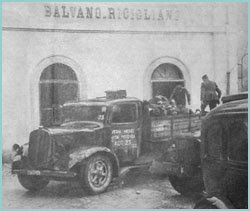 |
| Bodies were loaded on to trucks and taken away to be buried in mass graves |
Although the train, which originated in Naples, consisted only of goods wagons, it was packed with civilians travelling to the countryside in search of food, with many in the heavily bombed urban areas around Naples almost at the point of starving because of shortages.
Official reports classed these passengers as stowaways, although some accounts suggest that it was so common at the time for civilians to board freight trains in large numbers that there was a black market in unofficial tickets, and that most would have paid a fare.
The train left Naples on the afternoon of 2 March. It travelled at a low speed and made frequent stops as the line followed the coastline of the Bay of Naples, a heavily populated area, passing through Ercolano, Torre del Greco and Torre Annunziata before going inland through Pompei, Nocera Inferiore and the historic town of Cava de’ Terreni, rejoining the coast near Salerno, en route to the city of Potenza in Basilicata.
Until Salerno, the train had been pulled by an electric locomotive, but at that point the electrified line ran out. This meant that the remaining 100km or so of the journey, through increasingly mountainous terrain and frequent tunnels, would have to be completed under steam power.
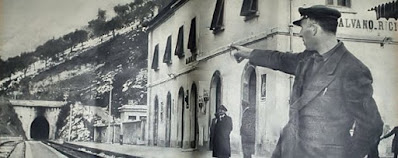 |
| Upon leaving Balvano-Ricigliano, trains go straight into a tunnel, although the disaster occurred in another tunnel |
Entering the Delle Armi tunnel, which is almost 2km long and has a gradient of 1.3%, the train’s wheels began to slip on rails wet from humidity and stalled. By the time it halted, about 800km into the tunnel, all but the last two wagons were in the tunnel.
Attempting to restart the train inside the tunnel would have been hazardous in any circumstances because of the amount of smoke generated but the problems for the crew were compounded by the fact that, because of shortages, they were reliant on a low-grade coal substitute that produced less power, but more carbon monoxide.
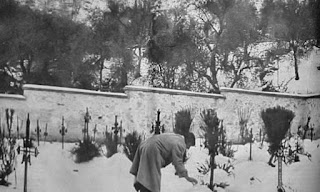 |
| Bodies of the victims were laid to rest in the local cemetery of Balvano |
The brakeman was one of only two crew to survive. He eventually walked back the 1.8km to the station, where the alarm was finally raised at 5.10am. By the time rescuers arrived, it was too late for many of the victims to be saved.
Although the tragedy was reported in Italian newspapers it was soon overtaken by other news. Barneschi believes that the Allies were keen that the event did not receive much attention anyway, fearful that stories of a liberated but starving local population would not reflect well on them. The Italians, meanwhile, embarrassed that their freight trains were carrying huge numbers of illegal passengers, may have similarly been happy for the incident to be forgotten.
There was an inquiry but no authority or individual was held responsible and no prosecutions resulted. Of the victims, only the railway employees were given proper funerals. The passengers were buried in four mass graves at the cemetery in Balvano, with no religious ceremony.
The exact death toll has never been established. The official tally, recorded in the minutes of the inquiry, was put at 517; Barneschi’s research, however, found that when the recovered bodies were laid out on the station platform at Bavano-Ricigliano, they numbered 626.
Travel tip:
Salerno in Campania has a pleasant waterfront yet
is often overlooked by visitors to the area
Salerno, situated some 55km (34 miles) south of Naples with a population of about 133,000, is a city with a reputation as an industrial port and is often overlooked by visitors to Campania, who tend to flock to Naples, Sorrento, the Amalfi coast and the Cilento. Yet it has an attractive waterfront and a quaint old town, at the heart of which is the Duomo, originally built in the 11th century, which houses in its crypt is the tomb of one of the twelve apostles of Christ, Saint Matthew the Evangelist. It is also a good base for excursions both to the Amalfi coast, just a few kilometres to the north, and the Cilento, which can be found at the southern end of the Gulf of Salerno. Hotels are also cheaper than at the more fashionable resorts.
Travel tip: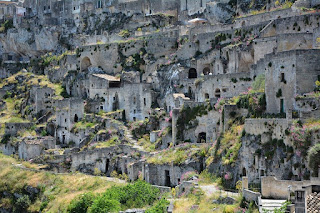
Some of the ancient cave-dwellings for which the
city of Matera has become famous
Although Basilicata, of which the city of Potenza is the regional capital, is not among Italy’s major tourist attractions, it has some dramatic scenery and a couple of gems in Matera and Maratea. Declared a European Capital of Culture in 2019, the city of Matera is famous for an area called the Sassi di Matera, made up of former cave-dwellings carved into an ancient river canyon. The area became associated with extreme poverty in the last century and was evacuated in 1952, lying abandoned until the 1980s, when a gradual process of regeneration began. Now, the area contains restaurants, hotels and museums and is an increasingly popular destination for visitors. Basilicata has two coastlines, one on the Ionian Sea, in the ‘arch’, so to speak, between the heel and toe of the Italian peninsula, the other on the Tyrrhenian Sea, south of the Cilento area of Campania, which is where visitors will find Maratea, a town built on a wooded hillside presiding over around 32km (20 miles) of rocky coastline and more than 20 beaches.
Also on this day:
1455: The birth of Borgia ally Cardinal Ascanio Sforza
1585: The inauguration of Palladio’s Teatro Olimpico
1768: The birth of composer Nicola Porpora
1882: The birth of fraudster Charles Ponzi



















